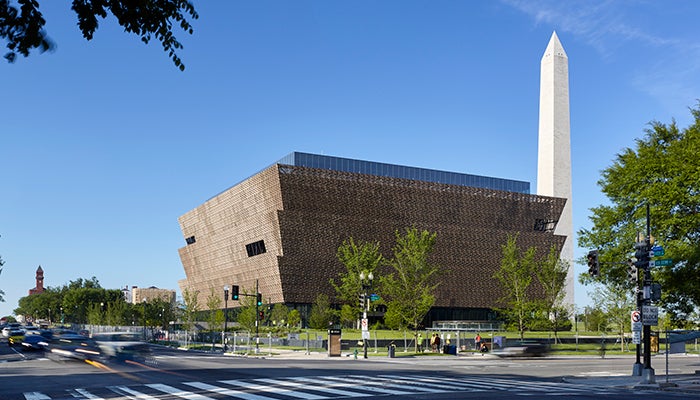
The site of the National Museum of African American History & Culture is intentional in both its placement and architectural design, according to museum officials. Photo credit: Alan Karchmer/NMAAHC
The Smithsonian National Museum of African American History & Culture (NMAAHC), the only national museum devoted exclusively to the documentation of African-American life, history, and culture, officially opened its doors on Sept 24. President Shirley Ann Jackson was one of several notable guests who spoke during the grand opening dedication ceremony for the museum.
NMAAHC was established by an act of Congress in 2003, establishing it as part of the Smithsonian Institution, following decades of efforts to promote and highlight the contributions of African-Americans.
The NMAAHC is a public institution open to all, where anyone is welcome to participate, collaborate, and learn more about African-American history and culture, according to the pillars upon which NMAAHC stands. In the words of Lonnie G. Bunch III, founding director of the NMAAHC, “there are few things as powerful and as important as a people, as a nation that is steeped in its history. This is America’s story and this museum is for all Americans.”
We have furthered the Smithsonian’s founding mission, to promote ‘the increase and diffusion of knowledge,’ by opening a museum dedicated to the African-American experience in the United States, and its crucial place in the American experience.—President Jackson
The Smithsonian Board of Regents, the governing body of the Institution, voted in January 2006 to build the museum on a five-acre site on Constitution Avenue between 14th and 15th streets N.W. The site is between the Washington Monument and the Smithsonian’s National Museum of American History. When the NMAAHC opens, it will be the 19th and newest museum of the Smithsonian Institution.
“We have furthered the Smithsonian’s founding mission, to promote ‘the increase and diffusion of knowledge,’ by opening a museum dedicated to the African-American experience in the United States, and its crucial place in the American experience,” said President Jackson, who also serves as vice chair for the Smithsonian Board of Regents.
The museum’s 12 inaugural exhibitions focus on broad themes of history (slavery and freedom, segregation, and 1968 and beyond), culture and community (power of place, sports, military history, and an exhibit titled “Making a Way Out of No Way”), music, cultural expressions, and visual arts. To date, the museum has collected more than 36,000 artifacts.
President Barack Obama and first lady Michelle Obama, along with former President George W. Bush and former first lady Laura Bush, joined members of Congress, the Supreme Court, and visitors from across the country on the National Mall during the ceremony.
Dedication ceremony speakers included President Obama; Smithsonian Secretary David Skorton, who received an honorary Doctor of Humane Letters degree during Rensselaer’s 210th Commencement Ceremony; Congressman John Lewis (D-Ga.), a veteran of the civil rights struggle of the 1960s, who received an honorary Doctor of Laws degree during Rensselaer’s 207th Commencement Ceremony; former President George W. Bush and former first lady Laura Bush; Chief Justice of the United States John G. Roberts Jr., chancellor of the Smithsonian, along with President Jackson, and NMAAHC Founding Director Lonnie Bunch.
“The opening of the National Museum of African American History & Culture and the future of natural history museums in the 21st century are subjects of great relevance to Rensselaer faculty and students, given our leadership in technologies with the potential to transform the museum experience, including cognitive and immersive systems, and data science and visualization,” President Jackson noted.


